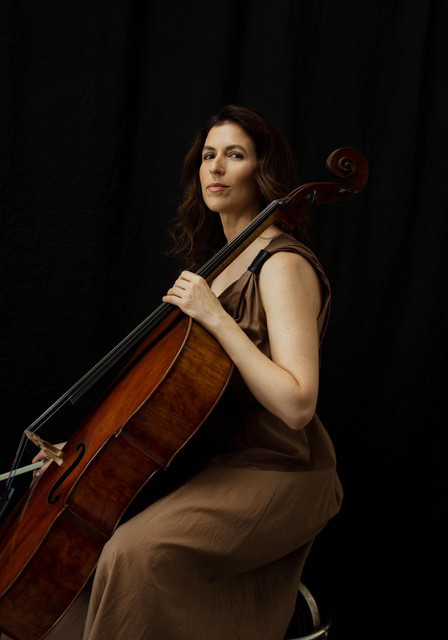Fairfax Symphony players shine in program’s invitation to the dance

Inbal Segev performed Anna Clyne’s Dance with the Fairfax Symphony Orchestra Saturday night.
The latest concert from the Fairfax Symphony Orchestra offered an entertaining array of music from roughly the last century. Music director Christopher Zimmerman united this enigmatic program around the theme of dance and folk music Saturday evening in the Harris Theatre at George Mason University. The smaller venue suited the slightly reduced size of the orchestra.
Sergei Prokofiev first composed his Overture on Hebrew Themes for the Zimro Ensemble, a Russian sextet combining clarinet, piano, and string quartet. The FSO played the composer’s later arrangement for chamber orchestra, which preserved a starring role for principal clarinetist Patrick Morgan on the melancholy opening dance tune. The upper string sections radiated warmth on their theme in the slower middle section.
Cellist Inbal Segev personally commissioned Dance, a recent cello concerto by Anna Clyne. After premiering the work as soloist in 2019, she brought it to northern Virginia in this performance. The British composer based the five-movement piece on a poem by Rumi, each line of which begins with the word “Dance.”
Segev’s tone on the A string hovered limpidly in the opening movement, shadowed by wisps of bowed vibraphone. The ruminative feeling of this opening section gave way to scampering woodwinds in the second movement, an earthy celebration featuring Segev’s solid figuration. The third movement centered a feeling of stability on a repetitive harmonic pattern, a nod to historic musical styles.
The cellist kept that steadiness of approach in the fourth movement, accompanied by the celli and double basses. The orchestra gradually came to life around Segev, adding instruments to a maelstrom of sound. At its climaxes the mysterious whooshing of a wind machine sounded, a moment stolen from a baroque opera scene. An odd combination of popular and serious styles drew the strands of this vivid tapestry together in the final movement, punctuated by percussive string pizzicati. Concertmaster David Salness took the funky and substantial violin solo with zest, adding folksy joy to the work’s conclusion.
Although Segev gave an accomplished performance of this intriguing concerto, Segev’s intimate tone was sometimes overwhelmed in the larger orchestral passages. Her introspective style suited her encore much better, the pensive Sarabande from Bach’s Solo Cello Suite No. 3.
Two lighter pieces by Stravinsky leavened the second half with mirth. In the Suite No. 2 for small orchestra, Stravinsky arranged humorous pieces first composed as piano duets to play with his children. The composer wrote the simpler upper part for a child’s hand, playing the more complicated accompaniment himself.
Trumpeter Chris Larios sparkled on the main theme of the opening Marche, a portrait of the pianist Alfredo Casella according to Stravinsky, bolstered by percussion in lockstep. The moony Valse, an homage to Erik Satie, featured lightly twirling woodwinds, followed by a less graceful Polka in square rhythm, a caricature of the impresario Sergei Diaghilev. The closing Galop sounded like Offenbach on steroids, a fitting end to this quirky collection.
Stravinsky premiered the neoclassical ballet Pulcinella in 1920, in a commedia dell’arte staging with sets and costumes designed by Pablo Picasso. He later excerpted about half of this charming music, based on actual 18th-century melodies then thought to be by Pergolesi, in the Suite heard at this concert. Zimmerman’s decision to program it was a sign of confidence in his musicians, as there are extensive demands placed on individual players, to which the FSO responded mostly with aplomb.
Oboist Emily Snyder Foster, also with the U.S. Air Force Band, distinguished herself in the Serenata and Gavotte movements with a resonant tone in extended solos across a broad range. Flutes and violin exchanged graceful lines with the horn in the Scherzino, swept away by the jaunty strings and woodwinds in the Tarantella. The most eccentric movement, Vivo, offered up comic solos for trombonist David Sisk and double bassist Aaron Clay. The horns had a strong turn in the soothing Minuetto, followed by an ebullient Finale for the whole ensemble.
Pianist Jeffrey Biegel joins the Fairfax Symphony Orchestra in Gershwin’s Rhapsody in Blue, plus music by Peter Boyer and Amy Beach, 4 p.m. June 9. fairfaxsymphony.org
